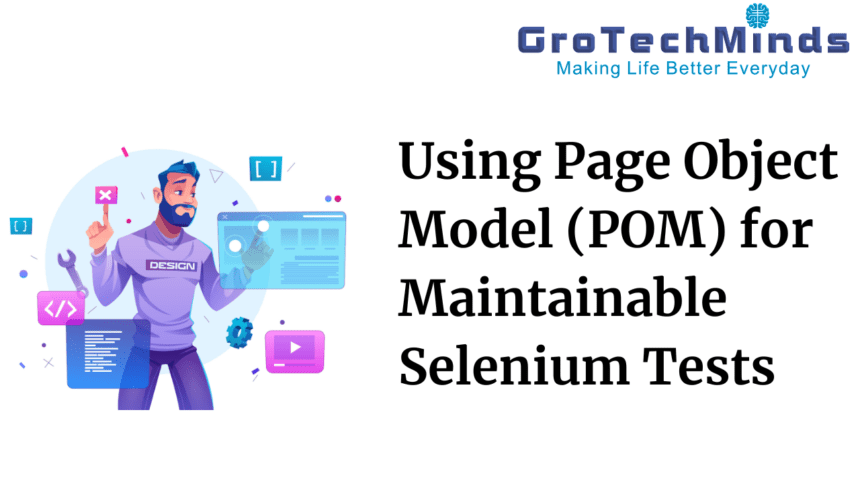In the field of software testing, Selenium has evolved as a formidable tool for automating web applications. However, as test suites grow in size and complexity, maintenance becomes more difficult. This is where the Page Object Model (POM) comes in, providing a structured approach to structuring Selenium tests that improves maintainability and scalability.
Introduction to Selenium and the Importance of Maintainable Tests
Selenium is a famous open-source technology for automating web browsers, which enables testers to imitate user interactions and evaluate web application functionality. Selenium, with its support for numerous programming languages and browsers, has emerged as a key component of modern test automation systems.
However, when test suites grow to include additional features and situations, they can become bulky and difficult to manage. Test code that lacks structure and organization can soon become a maintenance nightmare, requiring more effort and resources to keep up.
Enter the Page Object Model (POM).
The Page Object Model (POM) is a design pattern that seeks to address these issues by creating a clear distinction between test code and page functionality. In essence, each web page in an application is represented by a separate Page Object that encompasses the page’s features and actions.
POM encourages code reuse, readability, and maintainability by abstracting UI features into reusable components. Changes to the UI can be limited to the relevant Page Objects, decreasing the influence on test code and lowering the danger of cascade failure.
Anatomy of Page Object
A Page Object normally has two primary components: elements and methods.
Elements:
These are the UI elements on a web page, like text boxes, buttons, and dropdown menus. In POM, elements are typically identified using locators like XPath, CSS selectors, or IDs. By centralizing element locators into Page Objects, any changes to the UI can be simply changed in one location.
Methods:
These are the activities that can be taken on the page, such as completing a form, clicking a button, or confirming the presence of an element.
Benefits of Using POM for Selenium Testing
Improved maintenance:
POM organizes test code into reusable components, which makes it easier to comprehend and manage. Changes to the UI can be restricted to Page Objects, limiting the possibility of code duplication and inconsistency.
Enhanced readability:
By abstracting away the UI details, POM encourages clearer and more expressive test code. Testers can concentrate on designing high-level, business-oriented tests without becoming mired down in the complexities of HTML and CSS.
Increased Scalability:
As test suites become larger and more sophisticated, POM offers a scalable framework for managing test code. New tests can be added without affecting previous ones, allowing teams to develop and grow their automation strategies over time.
Faster Debugging and Troubleshooting:
POM makes it easier to diagnose and troubleshoot by centralizing element locators and page-specific functionality. Testers can easily find and resolve issues inside the relevant Page Objects, accelerating the development cycle.
Best Practices for Implementing POM
To maximize the potential of POM, consider the following best practices:
Create individual page objects for each web page:
Each web page in the application should have its own dedicated Page Object, which contains the page’s particular elements and methods.
Use descriptive method names.
Ensure that method names in Page Objects are clear and intuitive, allowing other team members to comprehend their purpose and application.
Parameterize the Page Object Methods:
Parameterize methods in Page Objects whenever possible to promote flexibility and reusable code.
Implement page object inheritance:
To eliminate duplication and encourage code reuse, consider providing inheritance between Page Objects. Common components and actions can be abstracted into a base Page Object, which is then inherited by individual page implementations.
Regularly review and refactor page objects:
As the program grows, examine and refactor Page Objects to ensure they remain consistent with the UI and business logic. Remove any unnecessary or old code to keep the test suite streamlined and efficient.
Challenges of Selenium Test Automation
Before delving into the benefits of adopting the Page Object Model (POM), it’s important to understand the obstacles that Automation testing with selenium frequently faces:
Brittleness:
Selenium automation testing can become brittle when they are firmly tied to the structure of a web page. Even slight UI changes can result in test failures, necessitating frequent revisions to the test code.
Code duplication:
Without adequate organization, test code is prone to duplication. Similar UI interactions may be repeated across numerous tests, resulting in higher maintenance overhead and error rates.
Maintenance is difficult.
Larger test suites are more difficult to maintain. The lack of structure and organization makes it difficult for testers to traverse and alter the test code, resulting in lower productivity and longer release cycles.
Readability Issues:
Test code without a clear structure and naming conventions might be difficult to understand, particularly for team members who are unfamiliar with the project. This might cause confusion and inefficiencies in the testing process.
Real-World Application of POM
To demonstrate the practical application of POM, consider this example of testing an e-commerce website:
LoginPage:
This Page Object encapsulates the login page’s elements and actions, such as username and password input fields and the login button.
HomePage:
The HomePage Page Object depicts the website’s primary landing page, which includes elements like the navigation menu, search bar, and product categories.
ProductPage:
This Page Object relates to the page that displays information about a given product, including the product name, description, price, and add-to-cart buttons.
Conclusion
The Page Object Model (POM) provides an organized approach to structuring Automation test with selenium, which improves maintainability and scalability. By enclosing page-specific logic in reusable components, POM increases code reuse, readability, and maintainability, resulting in more robust and efficient test automation efforts.



